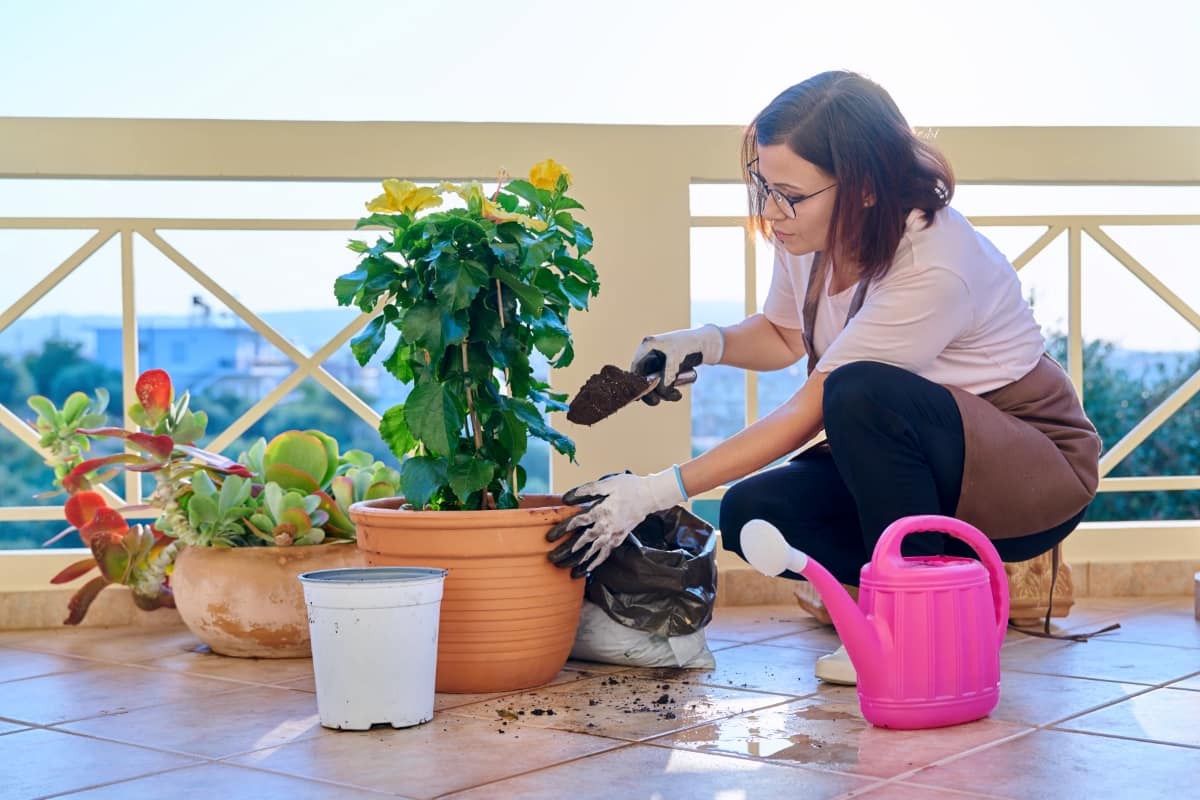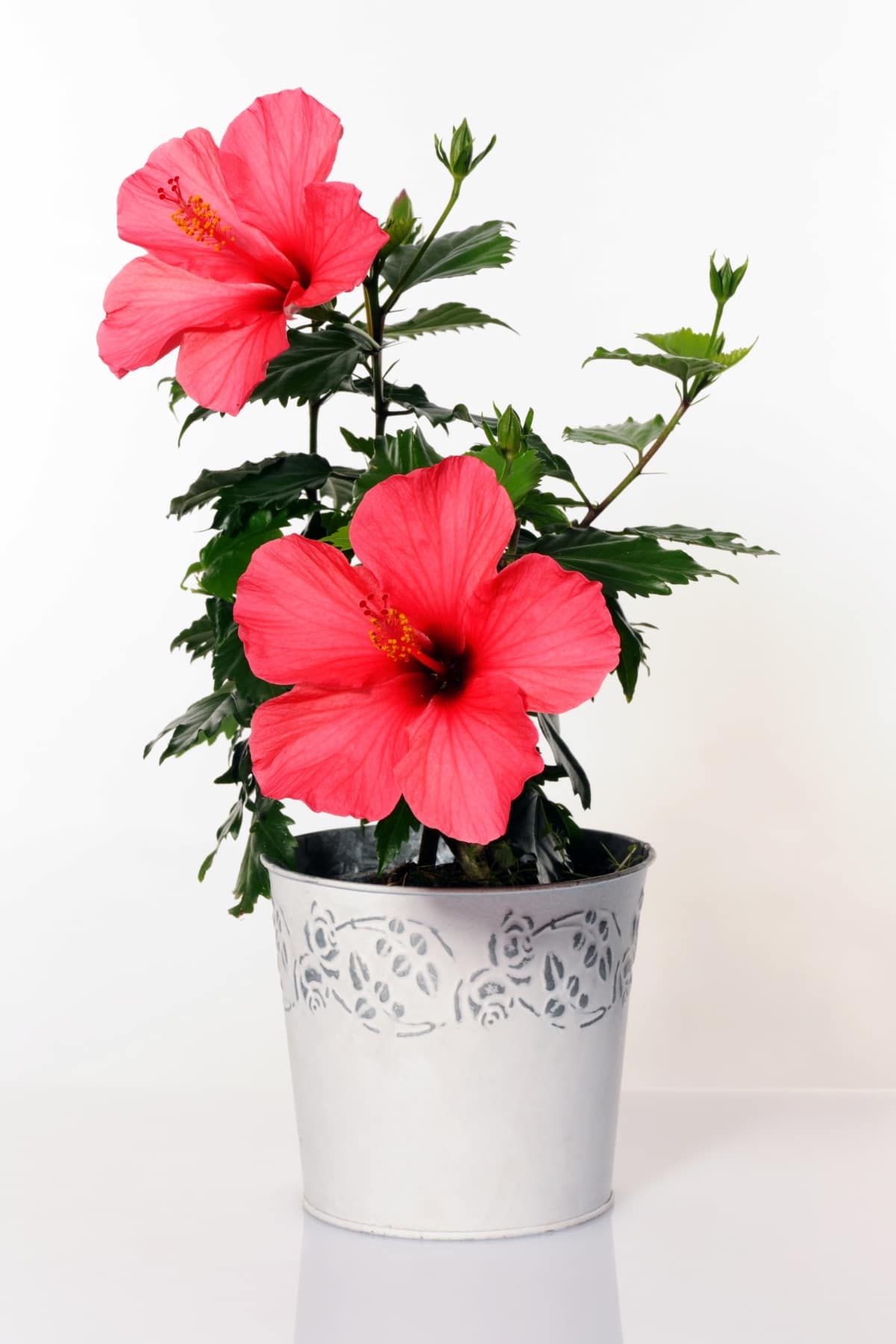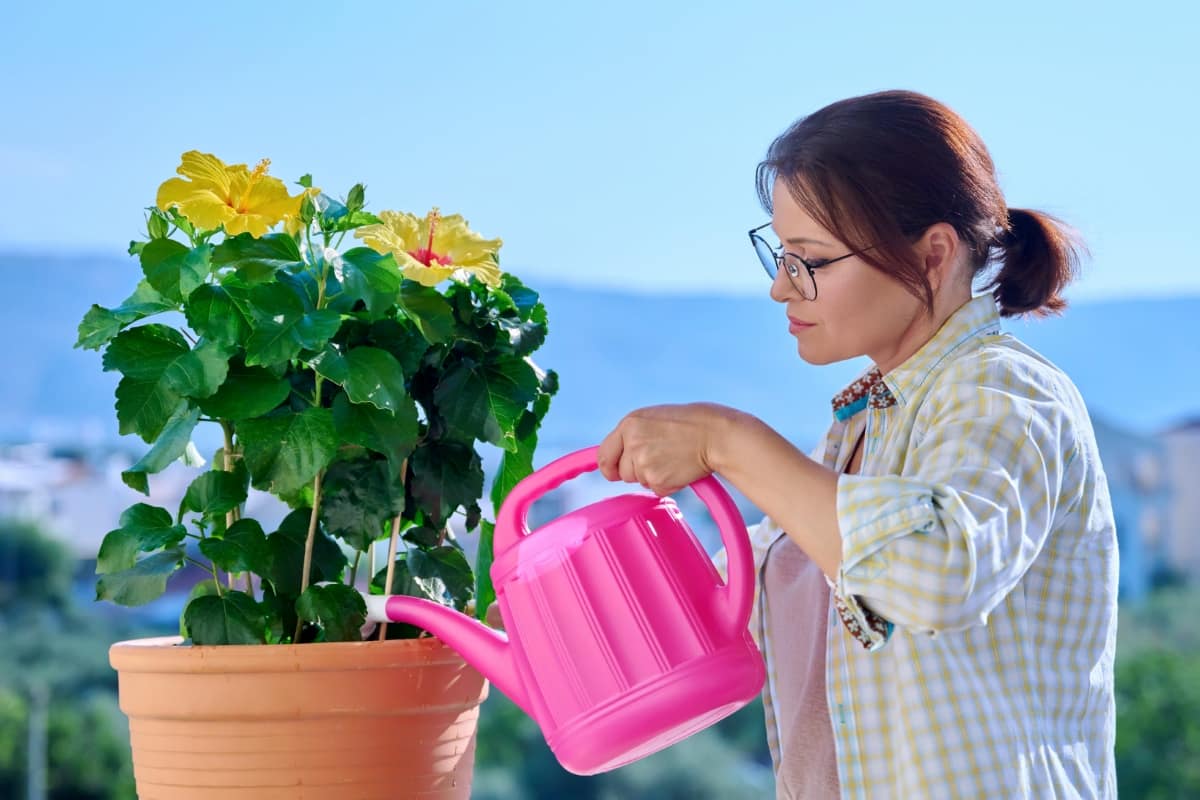Hibiscus is a strikingly beautiful and diverse genus of flowering plants renowned for their large, showy blooms. With over 200 species varying in shape, size, and color, these plants are a favorite choice for indoor and outdoor gardening enthusiasts. However, despite their tropical origins, hibiscus can be surprisingly resilient, even in less-than-optimal conditions. Properly caring for potted hibiscus involves understanding their requirements and ensuring those are met, whether they’re placed outdoors or indoors.

How to Care for Hibiscus in Pots
Cultivating Hibiscus Outdoors
Hibiscus thrives in warm, sunny conditions. When situated outdoors, they need at least six hours of sunlight daily. Without sufficient sunlight, they may not bloom as prolifically. However, hibiscus may benefit from light afternoon shade in areas with intense, scorching sun. When choosing a pot for your hibiscus, ensure it has ample drainage. Excessive watering is a frequent mistake when caring for hibiscus plants, as they are not tolerant of overly moist conditions. An oversized pot can also make it more challenging to control soil moisture levels.
Caring for Hibiscus Indoors
Caring for hibiscus indoors isn’t drastically different from outdoor care, but it requires certain adjustments. For instance, providing adequate light might be a challenge. Hibiscus needs plenty of light, so a bright, sunny window is ideal. If this isn’t available, consider supplementing with artificial light sources. Maintaining the right humidity level is also crucial indoors. Hibiscus prefers a higher humidity than most homes naturally provide, especially during winter when indoor heating systems can dry out the air. Regular misting or a room humidifier can help to address this.
How Often to Water Hibiscus in Pots
The question of how often to water hibiscus in pots is common, but the answer can depend on various factors. When watering plants, there are several factors to consider: pot size, soil type, plant size, and weather conditions. Generally, it is recommended to allow the top layer of soil to dry before watering. In hot and dry conditions, daily watering may be necessary, whereas in cooler and wetter conditions, watering once or twice a week may be sufficient. It is crucial to avoid overwatering, which can lead to root rot and other problems, thus exercising caution is advised.
How to Keep Hibiscus Blooming
The secret to how to keep hibiscus blooming prolifically lies in proper nutrition and light exposure. Hibiscus is a heavy feeder that requires regular high-potassium fertilizer applications to encourage blooms. During the growing season, feed your hibiscus every two weeks with a water-soluble, balanced fertilizer, and make sure it gets plenty of light. Pruning is another important aspect of care that encourages more blooms. Regularly removing dead wood and spent blooms will stimulate new growth and flower production.
In case you missed it: The Best Fertilizer for Hibiscus: When and How to Apply

Hibiscus Care in Winter and Summer
Hibiscus care changes slightly with the seasons. In summer, the plant needs more water to cope with increased evaporation. Ensure the plant is not subjected to waterlogged soil, as it may cause root decay. Reduce watering during winter while still avoiding complete dehydration of the plant. If you keep your hibiscus indoors, maintain high humidity and provide enough light.
As the temperature drops in late fall, it’s time to think about overwintering your hibiscus. If your plant is outdoors and your climate experiences harsh winters, you’ll need to bring the plant inside to a cool, bright room. If it’s impossible to bring it inside, mulching the base and wrapping the pot with insulation can offer some protection.
Remember, hibiscus is a tropical plant that can suffer severe damage or even die if exposed to freezing temperatures. During the summer, hibiscus thrives in warm temperatures, but protection from intense midday heat may be necessary, particularly in hot climates. Placing the plant where it gets morning sun but filtered light during the hottest day would be ideal.
Pest and Disease Management
Keeping your hibiscus healthy requires a proactive approach to pest and disease management. Pests such as aphids, whiteflies, and spider mites can be effectively managed using insecticidal soaps or neem oil. It is vital to regularly examine hibiscus leaves for indications of pests or disease as part of proper hibiscus care. Hibiscus is also susceptible to several diseases, including fungal infections like leaf spot and root rot. Most of these diseases are related to overwatering or poor drainage, reinforcing the need for well-draining soil and careful watering.
Pruning and Training Hibiscus
Pruning is a crucial aspect of hibiscus care that influences the plant’s shape and size and its overall health and flower production. Regular pruning helps promote bushier growth, encourages more blooms, and can improve air circulation, which helps prevent many diseases. Prune your hibiscus in early spring, just before new growth begins. Commence by eliminating any deceased or impaired branches, followed by concentrating on sculpting the plant. As hibiscus blossoms on fresh growth, do not hesitate to make substantial pruning.
Nevertheless, refrain from simultaneously removing more than a third of the plant’s foliage. Training is another important aspect, especially when growing hibiscus indoors. You can train your hibiscus to grow in a specific direction or shape by selectively pruning and using stakes or ties to guide the plant’s growth. This improves the plant’s aesthetics and can help manage its size, especially in indoor settings.
Repotting Your Hibiscus
Hibiscus plants can grow quite large; as they do, they may outgrow their pots. When a plant becomes root-bound—meaning its roots have filled the pot—it may show signs of stress like wilting, yellowing leaves, or stunted growth. It’s also worth noting that the plant will become top-heavy and may be prone to tipping over. These indicators suggest the need for repotting your hibiscus plant.
In case you missed it: How to Grow Hibiscus from Cuttings: DYI in 10 Simple Steps

When transferring your hibiscus to a new container, opt for a pot one or two sizes bigger than its current one. The new pot should have good drainage, just like the original. Gently remove the hibiscus from its current pot, trying to disturb the roots as little as possible. You may need to loosen the root ball with your fingers if the plant is root-bound. Transfer the plant into the new container, ensuring the roots are surrounded by new, porous soil. After repotting, thoroughly irrigate to stabilize the soil and facilitate the plant’s recuperation.
Conclusion
Caring for hibiscus in pots, whether outdoors or indoors, involves meeting their need for sunlight, managing their thirst for water without overdoing it, providing ample nutrition, and maintaining vigilance against pests and diseases. These elements of care become even more crucial in the changing demands of winter and summer.
- Feed Your Flock for Less: Top 10 Tips to Save on Chicken Feed
- Ultimate Guide to Ossabaw Island Hog: Breeding, Raising, Diet, and Care
- Hatching Answers: The Top 10 Reasons Your Chickens Aren’t Laying Eggs
- Eggs and Economics: Breaking Down the Cost of Raising Backyard Chickens
- Defend Your Greens: Proven Methods to Keep Iguanas Out of Your Garden
- Ultimate Guide to Cinnamon Queen Chicken: A Comprehensive Guide for Beginners
- Ultimate Guide to California Tan Chicken: Breeding, Raising, Diet, Egg-Production and Care
- Ultimate Guide to Marsh Daisy Chicken: Breeding, Raising, Diet, and Care
- 10 Types of Chicken Farming Businesses You Can Start for Profits